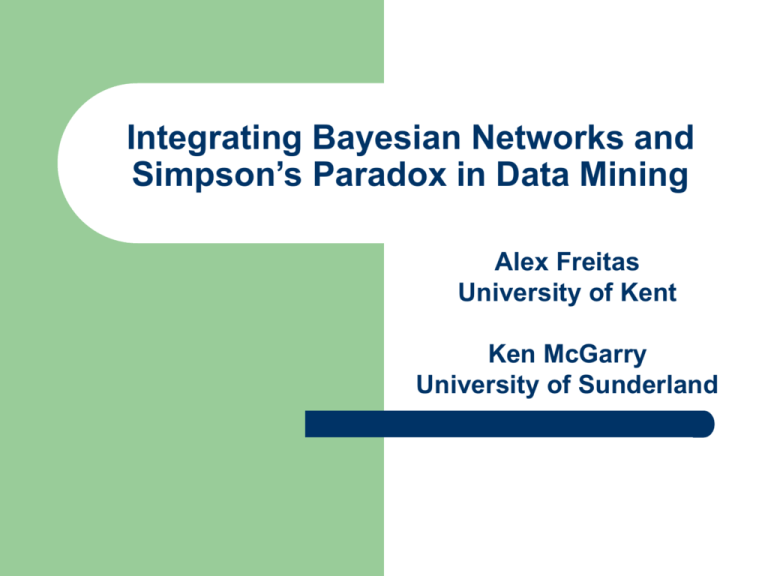Integrating Bayesian Networks and Simpson's Paradox in
advertisement

Integrating Bayesian Networks and Simpson’s Paradox in Data Mining Alex Freitas University of Kent Ken McGarry University of Sunderland Outline of the Talk 2 Introduction to Knowledge Discovery & Data Mining Constructing Bayesian networks from data Simpson’s paradox Proposed method for integrating Bayesian networks and Simpson’s paradox Conclusions Introduction Data Mining consists of extracting patterns from data, and it is the core step of a knowledge discovery process pre-proc Data 22, M, 30K 26, F, 55K ………. 3 data mining post-proc interesting patterns IF (salary = high) THEN (credit = good) The Knowledge Discovery Process – a popular definition “Knowledge Discovery in Databases is the non-trivial process of identifying valid, novel, potentially useful, and ultimately understandable patterns in data” (Fayyad et al. 1996) 4 Focus on the quality of discovered patterns – independent of the data mining algorithm This definition is often quoted, but not very seriously taken into account – A lot of research on discovering valid, accurate patterns – Little research on discovering potentially useful patterns Criteria to Evaluate the “Interestingness” of Discovered Patterns useful Amount of Research novel, surprising comprehensible valid (accurate) 5 Difficulty of measurement On the difficulty of discovering surprising patterns in data mining 6 Focus on maximizing accuracy leads to very accurate but useless rules, e.g. (Brin et al. 1997) – census data: – IF (person is pregnant) THEN (gender is female) – IF (age 5) THEN (employed = no) (Tsumoto 2000) extracted 29,050 rules from a medical dataset. Out of these, just 220 (less than 1%) were considered interesting or surprising to the user Motivation for Integrating Bayesian Networks and Simpson’s Paradox Bayesian network example A B C A Bayesian network represents potentially causal patterns, which tend to be more useful for intelligent decision making However, algorithms for constructing Bayesian networks from data were not designed to discover surprising patterns Simpson’s paradox is surprising by nature D 7 Causality + Surprisingness tends to improve Usefulness Constructing Bayesian Networks from Data Methods based on conditional independence tests – Methods based on search guided by a scoring function – – – 8 Not scalable to datasets with many variables (attributes) Iteratively create candidate solutions (Bayesian networks) and evaluate the quality of each created network using a scoring function, until a stopping criteria is satisfied Sequential methods consider a single candidate solution at a time Population-based methods consider many candidate solutions at a time Examples of sequential method – – 9 B algorithm starts with an empty network and at each iteration adds, to the current candidate solution, the edge that maximizes the value of the scoring function K2 algorithm requires that the variables be ordered and the user specifies a parameter: the maximum number of parents of each variable in the network to be constructed Both are greedy methods (local search), which offer no guarantee of finding the optimal network Population-based methods are global search methods, but are stochastic, so again no guarantees Limitations of methods for constructing Bayesian networks from data (1) Theoretical limitation (best possible algorithm & data) 10 Bayesian networks are Independence maps (I-maps) of the true probability distribution – Every independence between variables represented in the network is an actual independence in the true probability distribution – Dependences between variables represented in the network are not guaranteed to be actual dependences in the true probability distribution Limitations of methods for constructing Bayesian networks from data (2) Practical limitations 11 The problem of constructing the optimal net is too complex in large datasets, so we have to use methods which do not guarantee the discovery of the optimal net Sampling variation and/or noisy data may mislead the Bayesian network construction method, further contributing to the discovery of a sub-optimal net Simpson’s Paradox 12 (Pearl 2000) Overall E (recovered) Drug (C) 20 No Drug (C) 16 Total 36 E (not recov.) 20 24 44 Total 40 40 80 Recov. Rate 50% 40% Males E (recovered) Drug (C) 18 No Drug (C) 7 Total 25 E (not recov.) 12 3 15 Total 30 10 40 Recov. Rate 60% 70% Females E (recovered) Drug (C) 2 No Drug (C) 9 Total 11 E (not recov.) 8 21 29 Total 10 30 40 Recov. Rate 20% 30% Simpson’s Paradox as a Surprising Pattern Event C (“cause”) increases the probability of event E (“effect”) in a given population but, at the same time, decreases the probability of E in every subpopulation No paradox in terms of probability theory, it looks a “paradox” under a causal interpretation – 13 Gender is a confounder variable in the previous example Although Simpson’s paradox is known by statisticians, occurrences of the paradox are surprising to users There are algorithms that systematically find instances of the paradox in data and rank them in decreasing order of surprisingness (Fabris & Freitas 2006) The proposed method for integrating Bayesian networks and Simpson’s paradox Basic Idea: – 14 In a Bayesian network, the dependence denoted by edge C E can be spurious, i.e., due to a confounding variable F (for the previously discussed reasons) Two approaches exploring this basic idea First Approach: paradox detection before network construction First, run an algorithm that detects occurrences of Simpson’s paradox in data (Fabris & Freitas 2006) – 15 Produces a paradox list PL Modify Bayesian network construction algorithms to take into account this list, biasing the algorithms against including network edges involving the paradox Consider a potential dependence represented by the edge C E, where C is apparent cause of effect E – If variables C, E are associated in an occurrence of Simpson’s paradox in PL, the algorithm is biased against including edge C E in the network Consider a greedy algorithm that starts with an empty network and adds one edge to the network at a time, guided by a scoring function FOR EACH candidate edge A B compute the score of the network if A B is added to the network proposed extension penalize score if there is an occurrence of the paradox in list PL involving pair of variables A, B SELECT edge with highest score and add it to the network 16 The same basic kind of extension can be applied to an Estimation of Distribution Algorithm – EDA is a population-based evolutionary algorithm – It evaluates a complete candidate solution (network) at once FOR EACH candidate solution in the population compute the score of the network represented by the candidate solution 17 proposed extension penalize score in proportion to the number of paradox occurrences in list PL that are associated with direct dependences A B in the network Second Approach: paradox detection after network construction 18 First, construct a Bayesian network from data Use the network to “prune” the search space for the Simpson’s paradox detection algorithm The algorithm will focus its search on the pairs of variables for which there is a direct dependence (i.e., an edge A B ) in the Bayesian network For each pair of such variables, the algorithm will try to find a third variable that acts as a confounder between those two variables Bayesian net A B variables considered by Simpson’s paradox detection algorithm, considering the Bayesian net Cause Effect C D 19 A B C C C D Is there a counfounder? ? ? ? A paradox occurrence involving the above pairs of cause and effect variables would be even more surprising to the user, due to the structure of the network Limitation of the proposed integration method It is possible that the data does not contain any occurrence of Simpson’s paradox – Even if the algorithm does not find any paradox occurrence, this result is to some extent useful: – – 20 In this case the usefulness of the method is limited it gives us increased confidence that the dependences represented in the network are true dependences, rather than spurious ones This additional test complements (rather than replaces) conventional methods for evaluating Bayesian networks Conclusions We proposed a method for integrating two very different kinds of algorithm in data mining – Algorithms for constructing Bayesian networks – Algorithms for detecting Simpson’s paradox 21 Discover potentially causal, more useful patterns Discover surprising patterns, potentially more useful Hopefully, combining the “best of both worlds”, increasing the chance of discovering patterns useful for intelligent decision making by the user Future research: computational implementation of the proposed method and analysis of results Any Questions ?? Thanks for listening!






